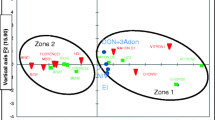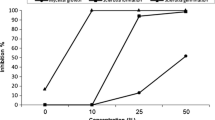Abstract
The total concentrations of free phenolic compounds and peroxidase were determined in spikes (collected at the flowering stage) of some spelt and common wheat cultivars differing in their response to F. culmorum infection. The antifungal activity of methanol extracts obtained from spikes was also evaluated. The tested genotypes differed significantly in their response to inoculation. The most resistant were Torka and Zebra among common wheat cultivars, and Weisser Grannenspelz among spelt cultivars. The average content of free phenolic compounds in spikes of spelt and common wheat was 1246.56 μg g−1 and 1236.58 μg g−1, respectively. The cultivars whose spikes contained the largest amounts of phenols showed the weakest response to F. culmorum infection. No significant differences were observed with regard to peroxidase content, which was 5.22 U g−1 in common wheat spikes and 5.14 U g−1 in spelt spikes. Methanol extracts from spikes of all wheat cultivars contained antifungal substances. The extracts from spelt spikes inhibited the growth of F. culmorum on PDA to a lesser degree than the extracts from common wheat spikes. This corresponds to the results of field trials, in which T. spelta generally exhibited a stronger response to F. culmorum infection than common wheat. The high correlation (r = 0.816) between mycelium growth inhibition on the medium and F. culmorum infection indicates that an evaluation of the antifungal activity of extracts from spikes may be used for the selection of breeding materials directed towards increased resistance to Fusarium head blight.
Similar content being viewed by others
References
Abdel-Aal E.-S.M., Hucl P., Sosulski F., Graf R., Gillott C. & Pietrzak L. 2001. Screening spring wheat for midge resistance in relation to ferulic acid content. J. Agr. Food Chem. 49: 3559–3566.
Bennett R.N. & Wallsgrove R.M. 1994. Secondary metabolites in plant defence-mechanisms. New Phytol. 127: 617–633.
Caruso C., Chilosi G., Leonardi L., Bertini L., Magro P., Buonocore V. & Caporale C. 2001. A basic peroxidase from wheat kernel with antifungal activity. Phytochem. 58(5): 743–750.
Chełkowski J. 1989. Formation of mycotoxins produced by Fusarium in heads of wheat, triticale and rye, pp. 63–84. In: Chełkowski J. (ed.), Fusarium — Mycotoxins, Taxonomy and Pathogenicity. Elsevier, Amsterdam.
Chrenkova M., Gálová Z., Čerešňáková Z. & Sommer A. 2001. Nutritional and biological value of spelt wheat. Acta fytotech. et zootech. 4: 191–193.
Grela E.R. 1996. Nutrient composition and content of antinutritional factors in spelt (Trtiticum spelta L.) cultivars. J. Sci. Food Agr. 71: 399–404.
Hoffmann W., Mudra A. & Plarre W. 1985. Lehrbuch der Züchtung landwirtschaftlicher Kulturpflanzen, Band 2, 2. Aufl. Spezieller Teil. Paul Parey, Berlin und Hamburg.
Klepacka J. & Fornal Ł. 2006. Ferulic Acid and its position among the phenolic compounds of wheat. Critic. Rev. Food Sci. Nutr. 46: 639–647.
Kunaeva R.M. 1986. Gidroliticeskie i oksilitelnye fermenty obmena fenolnych soedinenij rostenij. Izd. Nauka, Kazach. SRR, Ałma-Ata.
Marconi K., Carcea M., Graziano M. & Cubadda R. 1999. Kernel properties and pasta making quality of five European spelt wheat (Triticum spelta L.) cultivars. Cereal Chem. 76(1): 25–29
McKeehen J.D. & Fulcher G.R. 1998. Potential role of wheat phenolic acids during grain development in Fusarium resistance. In: 2nd International Electronic Conference on Synthetic Organic Chemistry (ECSOC-2), p. 207.
McKeehen J.D., Busch R.H. & Fulcher R.G. 1999. Evaluation of wheat (Triticum aestivum L.) phenolic acids during grain development and their contribution to Fusarium resistance. J. Agr. Food Chem. 47: 1476–1482.
Mesterhazy A. 1995. Types and components of resistance to Fusarium head blight of wheat. Plant Breed. 114: 377–386
Metlicki L. & Ozerereckovskaja O. 1984. Biochimija immuniteta rastenija k infekcjonnym bolezniam. Izd. Nauka.
Mohammadi M & Kazemi H. 2002. Changes in peroxidase and polyphenol activity in susceptible and resistant wheat heads inoculated with Fusarium graminearum and induced resistance. Plant Sci. 162: 491–498.
Moudry J. 1999. Productivity of spelt wheat (Triticum spelta L.) spike. Scientia Agric. Bohem. 30(1): 15–26
Nelson P.E., Toussoun T.A. & Marasas W.F.O. 1983. Fusarium — An Illustrated Manual for Identification. The Pennsylvania State University.
Parry D.W., Jenkinson, P. & McLeod L. 1995. Fusarium ear blight (scab) in small grain cereals — a review. Plant Pathol. 44: 207–238.
Perkowski J., Pavlová A., Šrobárová A., Stachowiak J. & Goliński P. 2002. Group B trichothecenes biosynthesis in wheat cultivars after heads inoculation with Fusarium culmorum isolates. Biologia 57: 765–771.
Rozenberg R., Ruibal-Mendieta L., Petiljean G., Cani P., Delacroix D., Delzenne M., Meurens M., Quetin-Lecler Q.J. & Habib-Jiwan J.-L. 2003. Phytosterol analysis and characterization in spelt (Triticum aestivum ssp. spelta) and wheat (T. aestivum L) lipids by LC/APCI-MS. J. Cereal Sci. 38: 189–197.
Rüegger A., Winzeler H. & Noseberg J. 1990. Die Ertragsbildung von Dinkel (Triticum spelta L.) und Weizen (Triticum aestivum L.) unter verschiedenen Umweltbedingungen im Freiland. J. Agron. Crop Sci. 164: 145–162.
Schmid J.E., Winzeler M. & Winzeler H. 1994. Analysis of disease resistance and quality characters of F1 hybrids of crosses between wheat (Triticum aestivum) and spelt (Triticum spelta). Euphytica 75: 105–110.
Schroeder H.W. & Christensen J.J. 1963. Factors affecting resistance of wheat to scab caused by Gibberella zeae. Phytopathol. 53: 831–838.
Siranidou E., Kang Z. & Buchenauer H. 2002. Studies on symptom development, phenolic compounds and morphological defence responses in wheat cultivars differing in resistance to Fusarium Head Blight. J. Phytopathol. 150: 200–2008.
Snijders C.H.A. 1990. The inheritance of resistance to head blight caused by Fusarium culmorum in winter wheat. Euphytica 50: 11–18.
Stallknecht G.F., Gilbertson K.M. & Ranney J.E. 1996. Alternative wheat cereals as food grains: einkorn, emmer, spelt, kamut and triticale, pp. 156–170. In: Progress in new crops. ASHS Press, Alexandria, VA.
Wieser H., Kieffer R., Mück U. & Reents H.J. 1998. Einfluss von Sorte und Standort auf Ertrag und Qualität von Dinkel aus ökologischem Landbau. Ber. Deut. Forsch. Lebensmitt., pp. 208–225.
Wiwart M., Perkowski J., Jackowiak H., Packa D., Borusiewicz A. & Buśko M. 2004. Response of some cultivars of spring spelt (Triticum spelta) to Fusarium culmorum infection. Die Bodenkultur 55(3): 103–111.
Author information
Authors and Affiliations
Corresponding author
Rights and permissions
About this article
Cite this article
Suchowilska, E., Wiwart, M. & Grabowska, G. Antifungal activity of methanol extracts from spikes of Triticum spelta and Triticum aestivum genotypes differing in their response to Fusarium culmorum inoculation. Biologia 63, 471–476 (2008). https://doi.org/10.2478/s11756-008-0075-2
Received:
Accepted:
Published:
Issue Date:
DOI: https://doi.org/10.2478/s11756-008-0075-2




